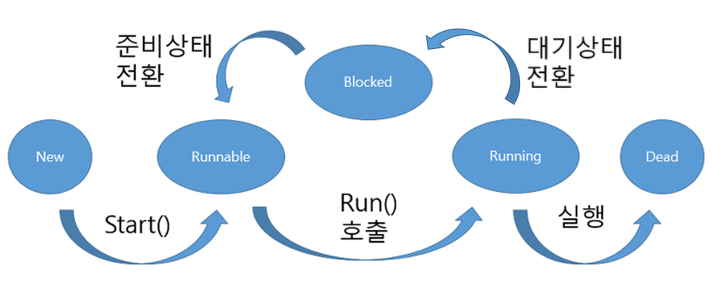- 한 프로그램이 하나 이상의 독립적인 서브태스크로 분리되어 실행될 때, 각 서브태스크를 쓰레드라 한다.
- 쓰레드는 별개로 실행하면서 CPU를 공동으로 사용한다. 하나의 프로세스에서는 동시에 여러 쓰레드가 실행 될 수 있다.
-
Runnable (준비상태) : CPU를 점유하고 있지 않으며, 코딩상에서 start() 메서드 호출로 run() 메소드에 설정된 상태로 진입한다. 보통 "Ready" 상태라고도 한다.
-
Running (실행상태) : CPU를 점유하고 있는 상태이며, run() 메서드는 JVM만 호출이 가능하다. Runnable에 있는 여러 쓰레드 중 우선 순위를 가진 쓰레드가 결정되면 JVM이 자동으로 run() 메소드를 호출하여 Running 상태로 진입시킨다.
-
Dead (종료상태) : Running 상태에서 쓰레드가 모두 실행되고 난 후 완료 상태이다. 보통 "Done"상태라고도 한다.
-
Blocked (지연상태) : CPU 점유권을 상실한 상태이다. 후에 특정 메서드를 실행시켜 Runnable상태로 전환시킨다. wait() 메서드에 의해 Blocked 상태가 된 쓰레드는 notify() 메소드가 호출되면 Runnable상태로 이동한다. 만약 sleep(n) 메소드에 의해 Blocked상태가 된 쓰레드는 지정된 시간이 지나면 Runnable상태로 돌아간다.
public class SingleThreadEx extends Thread{
private int[] temp;
public SingleThreadEx(String threadname){
super(threadname);
temp = new int[10];
for(int start=0;start<temp.length;start++){
temp[start]=start;
}
}
public void run(){
for(int start:temp){
try {
Thread.sleep(1000);
} catch (InterruptedException ie) {
ie.printStackTrace();
// TODO: handle exception
}
System.out.println("스레드이름:"+currentThread().getName());
System.out.println("temp value :"+start);
}
}
public static void main(String[] args) {
SingleThreadEx st = new SingleThreadEx("첫번째");
st.start();
}
}- 위 방법보다 많이 쓰인다.
public class SingleThreadEx2 implements Runnable{
private int[] temp;
public SingleThreadEx2(){
temp = new int[10];
for(int start=0;start<temp.length;start++){
temp[start]=start;
}
}
@Override
public void run() {
// TODO Auto-generated method stub
for(int start:temp){
try {
Thread.sleep(1000);
} catch (InterruptedException ie) {
ie.printStackTrace();
// TODO: handle exception
}
System.out.println("스레드이름:"+Thread.currentThread().getName());
System.out.println("temp value :"+start);
}
}
public static void main(String[] args) {
SingleThreadEx2 st2 = new SingleThreadEx2();
Thread t = new Thread(st2,"첫번째");
t.start();
}
}-
둘 다 run() 메소드를 오버라이딩하는 방식이라는 공통점이 있다.
-
하지만 쓰레드를 생성하는 방식에서 차이점을 보인다.
- Interface Runnable의 경우
- 해당 클래스를 인스턴스화하여 Thread 생성자에 매개변수로 넘겨줘야 한다.
- Class Thread를 상속하는 것과 달리 run() 메소드가 오버라이딩되어 따로 작성하지 않아도 된다.
- Class Thread의 경우
- 상속받은 클래스 자체를 쓰레드로 사용할 수 있다.
- 쓰레드 클래스의 메소드 (getName())을 바로 사용할 수 있다.
- Interface Runnable 상속의 경우엔 Thread 클래스의 static 메소드인 currentThread()를 호출하여 현재 쓰레드의 대한 정보를 참조하여야 한다.
- Interface Runnable의 경우
-
main 메소드 안에서 start() 를 통해 쓰레드를 실행한다. 하지만 start() 메소드가 아닌 run() 메소드가 있다. ?
-
직접 run() 메소드를 작성하여 작업지시를 해도 start() 메소드와 같은 결과가 나오지만 결과적으로는 쓰레드를 사용하는 것이 아니다.
-
Java에는 콜 스택이 있다. 이 영역은 실직적인 명령어들을 담고 있는 메모리로, 하나씩 꺼내서 실행시키는 역할을 한다. 만약 동시에 두 가지 작업을 한다면, 두 개의 콜 스택이 필요하다.
-
쓰레드를 사용한다는 것은 JVM이 다수의 콜 스택을 번갈아가며 일처리를 하고, 사용자는 동시에 작업하는 것처럼 보여주는 것이다.
-
run() 메소드를 이용하는 것은 main() 메소드의 콜 스택 하나만 이용하는 것으로 쓰레드 활용이 아니다.
(쓰레드 객체안에 있는 run() 메소드를 호출하는 것 뿐)
-
결국 start() 메소드는 쓰레드가 작업을 실행하는데에 필요한 콜 스택을 생성한 다음 run() 메소드를 호출해서 그 스택 안에 run() 메소드를 저장할 수 있도록 해주는 것이다.
-
-
쓰레드의 실행 순서는 예측할 수 없다.
-
이를 해결해기 위한 방법 Join !
-
Join
-
쓰레드를 생성한 쓰레드는 그 지점에서 기다려야 하기에 사용한다.
-
class MyThread implements Runnable{ private String threadName; public MyThread(String threadName){ this.threadName=threadName; } public void run(){ for(int i=0;i<100;i++){ System.out.println(threadName+":"+i); } } } public class ThreadTest { public static void main(String[] ar) throws InterruptedException{ System.out.println("MainThread Start"); Thread[] thread=new Thread[4]; for(int i=1;i<=3;i++){ thread[i]=new Thread(new MyThread("Thread"+i)); thread[i].start(); // thread[i].join(); // 아래 방법과 동일 } for(int i=1;i<=3;i++) thread[i].join(); System.out.println("MainThread End"); } } /* MainThread Start Thread1:0 Thread1:1 ... Thread3:99 MainThread End */
-
-
그리고 synchronized !
-
class ATM implements Runnable { private long depositeMoney = 10000; public void run() { synchronized (this) { for (int i = 0; i < 10; i++) { notify(); try { wait(); Thread.sleep(1000); } catch (InterruptedException e) { e.printStackTrace(); } if (getDepositeMoney() <= 0) break; withDraw(1000); } } } public void withDraw(long howMuch) { if (getDepositeMoney() > 0) { depositeMoney -= howMuch; System.out.print(Thread.currentThread().getName() + " , "); System.out.printf("잔액 : %,d 원 %n", getDepositeMoney()); System.out.println(depositeMoney); } else { System.out.print(Thread.currentThread().getName() + " , "); System.out.println("잔액이 부족합니다."); } } public long getDepositeMoney() { return depositeMoney; } } public class test { public static void main(String[] args) { ATM atm = new ATM(); Thread mother = new Thread(atm, "mother"); Thread son = new Thread(atm, "son"); mother.start(); son.start(); } }
- wait() : 스레드가 lock을 가지고 있으면, lock 권한을 반납하고 대기하게 만듦
- notify() : 대기 상태인 스레드에게 다시 lock 권한을 부여하고 수행하게 만듦
이 두 메소드는 동기화 된 영역 (synchronized) 내에서 사용되어야 한다.
동기화 처리한 메소드들이 반복문에서 활용된다면, 의도한대로 결과가 나오지 않는다. 이러할 때
wait() 과 notify() 를 try-catch 문에서 적절히 활용해 해결할 수 있다.
-
